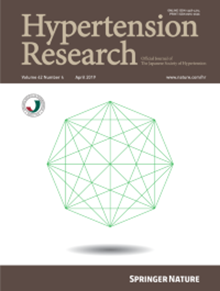Sodium appetite is enhanced in 5/6 nephrectomized rat by high-sodium diet via increased levels of angiotensin II in the subfornical organ
IF 4.6
2区 医学
Q1 PERIPHERAL VASCULAR DISEASE
引用次数: 0
Abstract
Intracerebral renin-angiotensin system (RAS) activation in the forebrain nuclei, such as the subfornical organ (SFO) is among the important factors that increase sodium appetite in rats. Although an increased sodium appetite in congestive heart failure and spontaneously hypertensive rats was reported previously, few reports have shown an increased sodium appetite in chronic kidney disease (CKD) model rats, for which salt restriction is important. Here, we aimed to verify whether CKD model rats show increased sodium appetite and if therapeutic intervention reducing sodium appetite by suppressing the intracerebral RAS is possible. In this study, 5/6 nephrectomized (5/6Nx) and control rats were fed a high-salt (4% NaCl) or low-salt (0.04% NaCl) diet. Angiotensin II (AngII) levels in kidney and the SFO, renal injury, and sodium appetite were evaluated after 2 weeks of salt loading. The 5/6Nx high-salt diet (Nx-HS) group was further divided into subgroups receiving continuous intracerebroventricular (ICV) administration of the angiotensin II type 1 receptor (AT1R) antagonist ZD 7155 or saline. Compared with the control rats, the 5/6Nx rats exhibited significantly increased levels of AngII in kidney and the SFO, accompanied by elevated blood pressure and worsened renal injury, especially in the Nx-HS group. In the Nx-HS group, an increased sodium appetite was observed that was attenuated by the ICV administration of ZD 7155 but not by saline. In conclusion, a high-salt diet enhanced the sodium appetite of 5/6Nx rats via increased levels of AngII in the SFO, which was attenuated by continuous ICV administration of an AT1R antagonist.

在5/6肾切除大鼠中,高钠饮食通过增加皮质下器官血管紧张素II的水平来增强钠的食欲。
脑内肾素-血管紧张素系统(RAS)在前脑核,如皮质下器官(SFO)中的激活是增加大鼠钠食欲的重要因素之一。虽然以前曾报道过充血性心力衰竭和自发性高血压大鼠的钠食欲增加,但很少有报道显示慢性肾脏疾病(CKD)模型大鼠的钠食欲增加,因此限制盐是重要的。在这里,我们的目的是验证CKD模型大鼠是否表现出增加的钠食欲,以及通过抑制脑内RAS来减少钠食欲的治疗干预是否可能。在本研究中,5/6只肾切除大鼠(5/6Nx)和对照大鼠分别饲喂高盐(4% NaCl)和低盐(0.04% NaCl)饲料。在盐负荷2周后,评估肾脏和SFO中的血管紧张素II (AngII)水平、肾损伤和钠食欲。5/6Nx高盐饮食(Nx-HS)组进一步分为亚组,接受连续脑室内(ICV)给药血管紧张素II型1受体(AT1R)拮抗剂ZD 7155或生理盐水。与对照大鼠相比,5/6Nx大鼠肾脏和SFO中AngII水平明显升高,伴有血压升高,肾损伤加重,其中Nx-HS组尤甚。在Nx-HS组中,观察到增加的钠食欲,通过ICV给药ZD 7155而不是生理盐水减弱。综上所述,高盐饮食通过增加SFO中的AngII水平来增强5/6Nx大鼠的钠食欲,而持续的ICV给药AT1R拮抗剂会减弱这种食欲。
本文章由计算机程序翻译,如有差异,请以英文原文为准。
求助全文
约1分钟内获得全文
求助全文
来源期刊

Hypertension Research
医学-外周血管病
CiteScore
7.40
自引率
16.70%
发文量
249
审稿时长
3-8 weeks
期刊介绍:
Hypertension Research is the official publication of the Japanese Society of Hypertension. The journal publishes papers reporting original clinical and experimental research that contribute to the advancement of knowledge in the field of hypertension and related cardiovascular diseases. The journal publishes Review Articles, Articles, Correspondence and Comments.
 求助内容:
求助内容: 应助结果提醒方式:
应助结果提醒方式:


